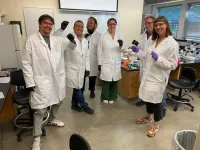(Press-News.org) At the close of 2023, Defra asked the British Ecological Society to bring together nearly 40 experts, to collate expert opinion on freshwater policy and set out a list of priorities for the biodiversity evidence programme to focus on. Published today, the new report sets out priorities for restoring England’s polluted fresh waters.
We know that England’s rivers, and the life they support, are in a desperate state. The River Trust’s annual State of Our Rivers report found that a mere 15% of rivers in England were classed as being in good ecological health and no single waterway was classed as being in good overall health. Calls to drastically improve the health of our rivers are getting louder and more urgent from all quarters.
The Environment Act (2021) sets out much-needed targets for both water quality and biodiversity, but the road to achieving these goals is complex. What’s more, current water targets do not provide flexibility for emerging threats such as climate change and novel chemical pollution, including Perfluoroalkyl and Polyfluoroalkyl Substances (PFAS), often termed forever chemicals.
This workshop resulted in the Delivering Biodiversity: priority actions for fresh water report which sets out how Environment Act targets deliver for biodiversity in freshwater and what priority actions should be taken to achieve them by 2030.
Priority actions
The report identifies priority actions for restoring freshwater biodiversity which include reducing pollution from agriculture, wastewater, and other sources; enhancing freshwater habitat connectivity; a more comprehensive approach monitoring; and an update to aquatic biodiversity indicators.
Incentivising farmers to reduce agricultural pollution
As Alan Lovell, Chair of the Environment Agency, pointed out at the NFU Conference, the uncomfortable evidence is that the agricultural sector is responsible for 40% of England’s river pollution, even more than water companies at 36%.
With 70% of England’s land farmed, a priority is to reduce the flow of agricultural pollution into our waterways. To do this, farmers should be better incentivised to take up regenerative agriculture practices, such as those which reduce the use of fertilisers, pesticides and herbicides as well as farming back from rivers, fencing off watercourses to keep livestock out, and planting riparian woodlands.
Rob Booth, Senior Policy Officer at the British Ecological Society said: "As our report recognises, land management actions to improve water quality are already financially rewarded in England through various schemes and offers, so the question is how to improve uptake. The report states that such actions should be 'rewarded appropriately' and given growing societal concern about cleaning up England's rivers, such actions would surely resonate with the public."
As well as incentives, farmers also need clear and independent advice, that is routed in ecological evidence, on delivering environmental sustainability.
Better regulation of sewage
Better monitoring and regulation of wastewater treatment works, along with improvements to infrastructure are essential to reducing sewage overflows. Priorities include targeting failing sewage plants, particularly those in headwaters to help improve biodiversity along the entire length of a river, and preventing combined sewage overflow dry spills (spills not caused by heavy rain).
Increased waterway connectivity
Making our rivers and floodplains more connected will improve the functioning and resilience of these ecosystems. Connectivity can be increased through removal of barriers such as weirs and restoring smaller water bodies like ponds, canals and wetlands which are often overlooked in monitoring and protection.
Widespread and comprehensive monitoring
Sustained investment in monitoring the state of biodiversity in our fresh waters, and the threats it faces, is essential. Without an uplift in monitoring, it will be impossible to know if Defra’s biodiversity targets are achieved, to accurately trace sources of pollution, or to fully understand the factors that impact the biological status of our fresh waters.
Updating aquatic biodiversity indicators
Freshwater invertebrates (such as insects and crustaceans) are currently used as the primary indicators of freshwater ecological quality. But the report argues that there is no single ‘best’ indicator of change in the water environment and several indicators are required to accurately monitor progress towards Defra’s biodiversity targets.
Quotes
Hazel Norman, CEO of the British Ecological Society, said:
“From shocking footage of sewage spills to in-depth reports, the dire state of England’s freshwaters has never been more visible to us. The government knows action needs to be taken and has set out vital targets for water quality and biodiversity, but achieving these goals is far from easy, with numerous interlinked pressures threatening our fresh water.
“The BES’s new report arms Defra with the ecological expertise needed to understand the pressures on our freshwater environments and sets out clear priority actions to turn the tide of biodiversity loss.”
Dr Steve Thackeray, Group Leader and lake ecologist at UKCEH and lead author of the report, said:
“Our precious freshwater ecosystems are home to a huge diversity of species and are always changing. They are very sensitive to pressures like pollution and climate change, so it is essential to invest in monitoring these habitats to gather robust evidence of change. Only then can we detect deterioration and track any improvements that arise through our actions”
Eleanor Andrews, Team Leader, Biodiversity Targets, Defra, said:
“The British Ecological Society have pulled together an informative report that sets out the numerous pressures on the freshwater environment. This report makes a valuable contribution to our biodiversity targets evidence programme.”
Dr Emma Jardine, Biodiversity Pressures Lead Scientist, Defra, said:
“The British Ecological Society’s report is helping us to build our understanding of the pressures on freshwater biodiversity and the actions that will be most impactful for target delivery.”
-ENDS-
END
NASA’s BurstCube, a shoebox-sized satellite designed to study the universe’s most powerful explosions, is on its way to the International Space Station.
The spacecraft travels aboard SpaceX’s 30th Commercial Resupply Services mission, which lifted off at 4:55 p.m. EDT on Thursday, March 21, from Launch Complex 40 at Cape Canaveral Space Force Station in Florida. After arriving at the station, BurstCube will be unpacked and later released into orbit, where it will detect, locate, and study short gamma-ray ...
Women experience disruptions in their sleep patterns and report heightened feelings of anger in the days leading up to their period, according to new research.
The study sheds new light on the intricate relationship between women's menstrual cycles, emotions, and sleep patterns.
Co-author Dr Jo Bower, of the University of East Anglia’s School of Psychology, said: “Our research provides valuable insights into the complex interplay between menstrual cycles, emotions, ...
Milan, Italy: Patients with breast cancer that has started to spread to the lymph nodes in the armpit can safely avoid extensive removal of the lymph nodes if their treatment is tailored to their response to cancer-killing therapies such as chemotherapy before surgery.
In a presentation to the 14th European Breast Cancer Conference today (Friday) in Milan, Annemiek Van Hemert, a doctor and PhD student in the Surgical Oncology Department of Antoni van Leeuwenhoek-Netherlands Cancer Institute (AVL-NKI) in Amsterdam (The Netherlands), said: “If we are able to predict the response based on the removal of ...
*This is an early press release from the European Congress on Obesity (ECO 2024) Venice 12-15 May. Please credit the Congress if using this material*
New research being presented at this year’s European Congress on Obesity (ECO) in Venice, Italy (12-15 May), suggests that replacing sugar-sweetened food and drinks with low/no energy sweetened products can help weight control for at least one year after rapid weight loss in adults, without increasing the risk of type 2 diabetes or cardiovascular disease.
The findings of a year-long randomised controlled trial involving adults with overweight and obesity and children in the overweight range from Northern, Central and ...
BOSTON (MA), March 21, 2024 – This July, the 13th annual International Space Station Research and Development Conference (ISSRDC) returns to Boston, where leaders from the commercial sector, U.S. government agencies, and academic communities will assemble to highlight innovations and opportunities through our nation’s orbiting outpost. ISSRDC will take place July 30-August 1, 2024, at the Marriott Copley Place in Boston. Early registration is now open until May 24, 2024. Booking during early ...
WOODS HOLE, Mass. –Twelve accomplished science and health journalists have been awarded a highly competitive fellowship in the Logan Science Journalism Program at the Marine Biological Laboratory (MBL).
Now in its 37th year, the Logan Science Journalism Program provides journalists with immersive, hands-on research training, giving them invaluable insight into the practice of science as well as some of the major news stories of today. The program, which offers a Biomedical course and an Environmental course, will run May 13-23 in Woods Hole.
Biographies for the 2024 Logan Science Journalism Fellows are here. They are:
Biomedical Fellows
Pakinam Amer, Independent ...
DURHAM, N.C. -- Physicians and biomedical engineers at Duke University have developed a method to visualize the growth of a placenta throughout a mouse’s pregnancy. By coupling an implantable window with ultrafast imaging tools, the approach provides the first opportunity to track placental development to better understand how the organ functions during pregnancy.
This new perspective gives researchers a precise way to examine how lifestyle factors like alcohol consumption and health complications like inflammation can affect the placenta and potentially lead to adverse pregnancy outcomes.
The research appears March 20 as the cover ...
The American Meteorological Society continuously publishes research on climate, weather, and water in its 12 journals. Many of these articles are available for early online access–they are peer-reviewed, but not yet in their final published form.
Below is a selection of articles published early online recently. To view full article text, members of the media can contact kpflaumer@ametsoc.org for press login credentials.
Observed Changes in Extreme Precipitation Associated with United States Tropical Cyclones
Journal of Climate
Rainfall ...
URBANA, Ill. – Agricultural occupations are hazardous with one of the highest rates of workplace injuries and fatalities in the U.S. The manual and often strenuous nature of the work, combined with the use of machinery and exposure to environmental hazards create a challenging work environment. Understanding the nature and causes of injuries can help improve safety guidelines and policy measures. However, obtaining a comprehensive overview of injuries is hindered by the absence of a central reporting system. Two ...
In a mouse study, UCLA researchers tested a vaccine against the bacterium that causes melioidosis and found it was highly protective against the disease, which is endemic in many tropical areas, causing approximately 165,000 cases with 89,000 fatalities around the world each year.
The bacterium, called Burkholderia pseudomallei, is spread through contact with contaminated soil and water through inhalation, ingestion or broken skin. It is so dangerous that it is categorized as a Tier 1 Select Agent of bioterrorism, and it can cause ...







